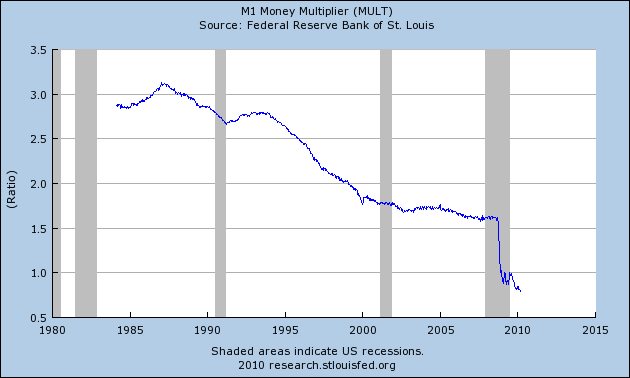It ain’t over ’till it’s over

{ Barron’s notes that the M1 money multiplier biweekly indicator is worth watching closely. | Barry Ritholtz | Continue reading }

{ Barron’s notes that the M1 money multiplier biweekly indicator is worth watching closely. | Barry Ritholtz | Continue reading }
 Vatican’s chief exorcist says Devil is in Vatican. Father Gabriele Amorth said people who are possessed by Satan vomit shards of glass and pieces of iron.
Vatican’s chief exorcist says Devil is in Vatican. Father Gabriele Amorth said people who are possessed by Satan vomit shards of glass and pieces of iron.
The French railway operator, SNCF, has mistakenly put a dramatic statement on its website saying more than 100 people had died in a train explosion. The false announcement, of an explosion in Macon in the Burgundy region, was part of a training exercise.
Man used his penis to assault female police officer. 5 more penis-related attacks.
Naked man escapes Swiss brothel fire.
The super-sized 43st mother who is determined to become the world’s fattest woman.
2500 of the world’s stock of 5000 languages are expected to die by the end of the century.
Excerpts from the Lehman Report.
The cocaine conundrum. Effective treatment remains elusive.
The further back in time we go, the more and more fragmented the Earth’s geological record becomes.
Interview with Andrey Ternovskiy, 17 year old founder of Chatroulette.
If a stranger came up to you on the street, would you give him your name, Social Security number and e-mail address?How privacy vanishes online.
 Tribune Company CEO Randy Michaels has banned 119 “newsspeak” words and phrases from ever crossing the lips of anchors and reporters at WGN-AM. There’s a list here, but if you’d like them in a sentence, how about this.
Tribune Company CEO Randy Michaels has banned 119 “newsspeak” words and phrases from ever crossing the lips of anchors and reporters at WGN-AM. There’s a list here, but if you’d like them in a sentence, how about this.
How women artists fought back in the ’70s.
Lucian Freud: the year I sat for the master. He has painted the grand and the famous - from the Queen to Kate Moss. So what is it like posing for the great man?
How Kenny Rogers and Frank Sinatra could help stroke patients.

{ New Balance 365, a collection of 365 short films that engages consumers 365 days a year by asking them to think about “the balance”. | Mother NY }

In real life, nothing happens like switching on a light bulb. Those are sort of poetic notions. In the real business world and the real world, it’s a learning curve. You learn a little bit and you learn some more, learn some more, and you’ve got to keep in the race.
{ Gene Simmons | Continue reading }
Be true to your own act and congratulate yourself if you have done something strange and extravagant to break the monotony of a decorous age.
headline { Magnolia, 1999 }
photo { Estelle Hanania }

In movies when they show a person walking down a crowded New York sidewalk the people are always mysteriously headed in the same direction. Navigation is actually a little more complicated than that.
{ S Shirazi | Continue reading | Courtesy of Daniel S. L., who wrote: “ Interesting dissection/take down of Starbucks at 39 . The clean bathrooms shouldn’t be undersold, however. In NYC Starbucks basically serve as the city’s only reliable facilities.” }
photo { Gosia Wieruszewska }
Solitude and Leadership
If you want others to follow, learn to be alone with your thoughts
My title must seem like a contradiction. What can solitude have to do with leadership? Solitude means being alone, and leadership necessitates the presence of others—the people you’re leading. (…)
Leadership is what you are here to learn—the qualities of character and mind that will make you fit to command a platoon, and beyond that, perhaps, a company, a battalion, or, if you leave the military, a corporation, a foundation, a department of government. Solitude is what you have the least of here, especially as plebes. You don’t even have privacy, the opportunity simply to be physically alone, never mind solitude, the ability to be alone with your thoughts. And yet I submit to you that solitude is one of the most important necessities of true leadership.
{ William Deresiewicz | The American Scholar | Continue reading }
A physical object like Mont Blanc or a species of plant or animal can be the subject of aesthetic analysis and evaluation, but such analysis is not part of natural science. Similarly, any human artistic activity has a psychological and eventually a neuro-physiological or biochemical basis, but this does not make a study of the brain activity of Michelangelo while he was painting part of “the humanities” (as we would call them). Neither is it the case that there is some specific method or set of characteristic methods used by the natural as opposed to the cultural sciences (or vice versa). Precise observation is equally important everywhere, and the basic forms of logical inference and evidentiary argumentation are similar in all scientific disciplines. Nevertheless, Windelband argued, there is an important distinction between the two basic kinds of “science”; it is merely that the distinction is not in terms of methods or subject matter but in terms of goals or aims.
{ Raymond Geuss, Goals, Origins, Disciplines | Continue reading | PDF }

What distinguishes women with unusually high numbers of sex partners?
We recruited two groups of women who differed in their number of lifetime sex partners in order to investigate several hypotheses related to female sociosexuality. Specifically, we explored whether women who engage in casual sex have low mate value, are especially likely to have come from stressful family environments, or are masculine in other respects besides their interest in casual sex.
Women with many partners were not lower than other women on direct or indirect indicators of mate value. Nor were they more likely to recall adverse family environments during childhood.
On several measures related to masculinity, women with many sex partners were elevated compared with other women.
illustration { Stuart Patterson }
During his swindling career, Mr. Quinn helped run a giant boiler-room operation out of a villa overlooking the French Riviera, had a champion racehorse and was alleged to have helped former financier Martin Frankel pull off one of history’s largest insurance frauds. U.S. authorities say he stole an estimated $500 million total.
His record, which includes three SEC injunctions and two federal criminal convictions, stretches back to 1966 when regulators barred the 28-year-old Mr. Quinn from the brokerage business for peddling shares of a bogus Florida land company. In 1992, a federal judge called Mr. Quinn an “incorrigible” recidivist whose business activities “appear to be devoted exclusively to securities fraud.” Yet he has served a total of only about six years in prison—with most that in France.
All of that could change now. Last November, at the age of 72, he was arrested by federal agents as he stepped off a plane from Ireland at John F. Kennedy Airport and charged with helping orchestrate a $50 million telecommunications fraud.
bonus:


As long as we’re on the topic of impulsivity, a brief remark about the word ‘manipulative,’ which I’ve found to be a remarkably overused, overrated explanation for the behavior of inflexible-explosive children. To me, the act of manipulation requires a fair amount of forethought, planning, affective modulation, and calculation — qualities that are in short supply in the vast majority of the inflexible-explosive children I know. Given that few of us enjoy being manipulated, believing that a child is being manipulative often causes adults to behave in counterproductive ways and hinders their consideration of more accurate explanations.
{ Ross Greene, The Explosive Child, 1998 | Thanks Blue M.! }

Climate scientists have long warned that global warming could unlock vast stores of the greenhouse gas methane that are frozen into the Arctic permafrost, setting off potentially significant increases in global warming.
Now researchers at the University of Alaska, Fairbanks, and elsewhere say this change is under way in a little-studied area under the sea, the East Siberian Arctic Shelf, west of the Bering Strait.

How loud does something have to be to kill someone? I heard once on BattleBots that it took 150 decibels to stop the human heart. Is this true? If so, I’m afraid, since I work in a VERY loud job environment (I assemble 747 engines). So is there a fatal decibel level? And if so, is it really 150 decibels? Please tell me. I’m scared.
A 150-decibel noise isn’t loud enough to kill you, and even if it were, the immediate cause of death in most cases wouldn’t be direct trauma to the heart. But the TV show was right in the big-picture sense: if a noise were loud enough, you’d die.
What we’re talking about here is high-energy-impulse noise, also known as blast overpressure or air blast, which is “the sharp instantaneous rise in ambient atmospheric pressure resulting from explosive detonation or firing of weapons” (N.M. Elsayed, “Toxicology of Blast Overpressure,” Toxicology, 1997). What, you say this isn’t noise in the usual sense? Nonsense. It’s no different from a thunderclap or a sonic boom. It’s true you might not hear a truly titanic air blast, but that’s because your eardrums would shatter, and worst case you’d be dead.
photo { Esther Mathis }
quote { Aldous Huxley! }
What to do if cracks appear in a marriage—from seeking counseling to calling it quits. (…)
Many couples work out what to do on their own.
But what should clashing couples do? Marriage counseling became a popular answer to that question after marital referees first appeared in the U.S. in the 1930s. (…) Counseling for couples gradually grew to be an entrenched social phenomenon. (…)
It is all going reasonably well— until Chris decides that he wants to leave. She never quite figures out what went wrong, numbering each possibility as it occurs to her. (There are more then 300 by book’s end.) Even a decent marriage, Ms. Morrison learns, can turn heartbreaking.

{ Read more | 5W Infographics }

{ Leda and the Swan, copy after a lost painting by Michelangelo, c. 1530 }

{ François Boucher, Leda and the Swan, 1741-1742 | Read more }

{ François Boucher, Leda and the Swan, c. 1740 }

{ Leda and the Swan, Scindia museum, Gwalior }

{ Leda and the Swan by Norman Parkinson, 1980s }
Leda and the Swan is a motif from Greek mythology, in which Zeus came to Leda in the form of a swan.
The subject undoubtedly owed its sixteenth-century popularity to the paradox that it was considered more acceptable to depict a woman in the act of copulation with a swan than with a man.
Leonardo da Vinci began making studies in 1504 for a painting, apparently never executed, of Leda seated on the ground with her children. In 1508 he painted a different composition of the subject, with a nude standing Leda cuddling the Swan, with the two sets of infant twins, and their huge broken egg-shells.
After something of a hiatus in the 18th and early 19th centuries (apart from a very sensuous Boucher), Leda and the Swan became again a popular motif in the later 19th and 20th centuries, with many Symbolist and Expressionist treatments.
Cy Twombly executed an abstract version of Leda and the Swan in 1962.
{ Wikipedia | Continue reading | Bonus: Doggie style by Fred Inaudi }

{ Cameron Diaz, Elastigirl, Michael Caine | Randy Glass, The Wall Street Journal portraits | more }